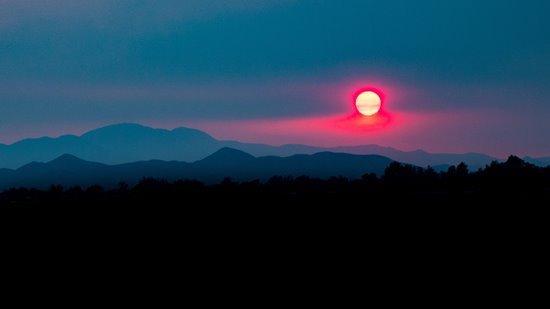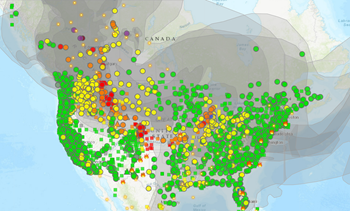Wildfires Can Impact Your Indoor Air Quality and Health

If you watch a sunset or wake up to a sunrise that lights up the sky more than usual, it could be due to an abundance of particles floating around the atmosphere. While they may make a sunset or sunrise beautiful, these particles can harm your health.
What particles cause the sunset to look so beautiful?
The largest source of these particles is forest fires. Forest fires are most common in North America in the drier summer months. That timeframe can shift earlier or later in any given year, but summer is generally the timeframe. Fires create smoke. According to the EPA, All smoke contains carbon monoxide, carbon dioxide, and particulates. These particulates reflect and disperse the light from the sun, making the sunset or sunrise look more beautiful. But many people don’t fully understand the impact of the small particles. Those particles can significantly affect your health.

When talking about air quality, whether indoor or outdoor, we pay extraordinary attention to the sizes and types of particles in the air. The smaller the particle, the greater the risk to your health. Like those found in smoke, ultra-fine particles are easily absorbed into your bloodstream. Generally, we use a scale from PM10 to PM1 when referencing particulate matter. In diameter, pollen, dust, and mold are around 10 microns (PM10). Combustion particles, organic compounds, metals, etc., are approximately 2.5 microns (PM2.5) in diameter. Particles of 1 micron in diameter are often very similar to PM2.5, only smaller, and can enter the bloodstream more quickly. In a forest fire, there are a lot of PM1 and PM2.5 particles, which is why the EPA and NOAA send out alerts as the wind shifts, sending smoke over the entire country. (image here)
Why are these particles harmful to my health?
It’s common knowledge that carbon monoxide and carbon dioxide harm our health. After all, we put detectors in our homes to alert us to their presence. But those tiny particles can enter your bloodstream and cause serious health concerns. According to the New York State Government, “all smoke contains carbon monoxide, carbon dioxide and particulate matter (PM or soot). Smoke can contain many different chemicals, including aldehydes, acid gases, sulfur dioxide, nitrogen oxides, polycyclic aromatic hydrocarbons (PAHs), benzene, toluene, styrene, metals, and dioxins” and many of these tiny particles that are known to cause things like cancer and even Alzheimer’s disease. About particulate matter’s effect on our health the EPA says, “the effects of particulate matter exposure range from eye and respiratory tract irritation to more serious disorders including reduced lung function, bronchitis, exacerbation of asthma, heart failure, and premature death. Short-term exposures (i.e., days to weeks) to fine particles, a major component of smoke, are associated with an increased risk of premature mortality and aggravation of pre-existing respiratory and cardiovascular disease. In addition, fine particles are respiratory irritants and exposure to high concentrations can cause persistent cough, phlegm, wheezing, and difficulty breathing. Fine particles can also affect healthy people, causing respiratory symptoms, transient reductions in lung function, and pulmonary inflammation. Particulate matter may also affect the body’s ability to remove inhaled foreign materials from the lungs, such as pollen and bacteria. Specific life stages and populations may be at increased risk of health effects due to particulate matter exposure. Actions should be taken to reduce their exposure to wildfire smoke.”
How can you protect yourself from the particles in wildfire smoke?
Stay indoors if you are particularly susceptible to fine particle pollutants. Close your doors and windows and run a quality air purifier with a True HEPA filter. Also, consider running your furnace or air conditioner fan, often called an AHU. With a newer thermostat model, you can run the fan without the actual furnace or air conditioner. Ensure the filter attached to your AHU is the highest level rated for your AHU. If you can, install a HEPA filter to capture almost all the pollutants in your air. If you have a very energy-efficient home, your building envelope is likely very tight, so you’ll have to bring air into your house at some point. If you have a https://broan-nutone.com/en-us/fresh-air-systems/residentialfresh air system, ensure the filter is clean. Upgrade to a MERV 13 or HEPA filter if your fresh air system can handle it. Do not use any air purifier that adds something to the air, such as ozone. Ozone can cause its own set of health concerns.
Don’t risk your health during forest fire season. Stay indoors if you need to, filter your air, and stay healthy.

 English
English
 English
English